What Do Chickens Eat? An Ultimate Guide

Although chickens are not picky eaters, making sure they are getting a balanced diet is important for their health and egg production. From the early stages of life to adulthood, understanding what chickens can eat is something every chicken owner should know.
In this article, we’ll explore the dietary needs of chickens at different life stages, safe table scraps, supplements, and treats to keep your flock happy and healthy.
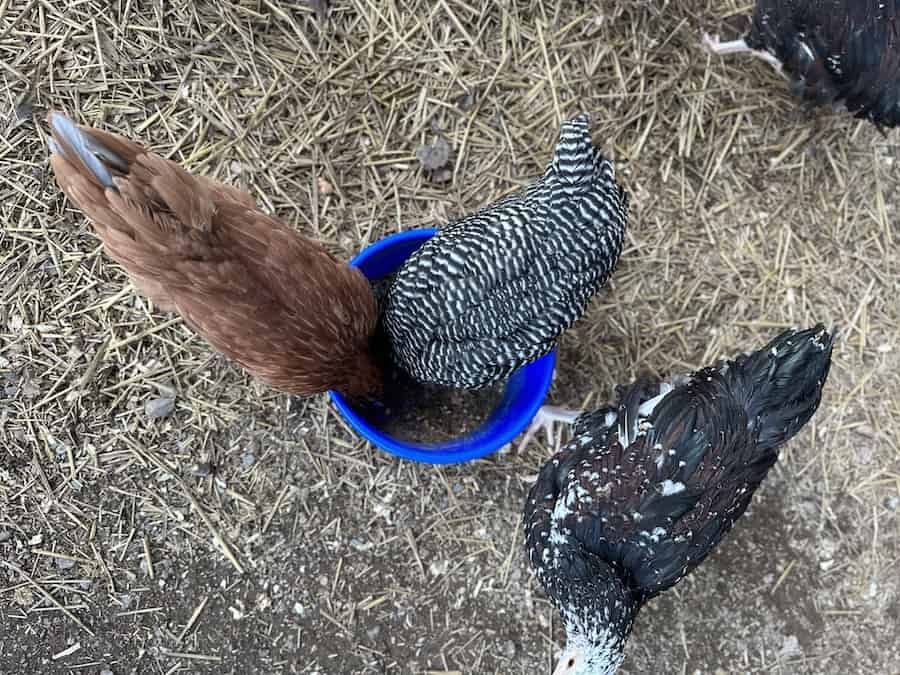
Disclaimer: This article includes affiliate links. If you click one of them, we may receive a small percentage of the sale at no extra cost to you. Thank you for your support!
Stages Of Life And Dietary Needs
There are three main stages of life for chickens that require particular feeds: chick, pullet/cockerel and hen/rooster. Each feed is formulated to help chicks grow into healthy chickens.
Chick Starter Feed (0-8 weeks)
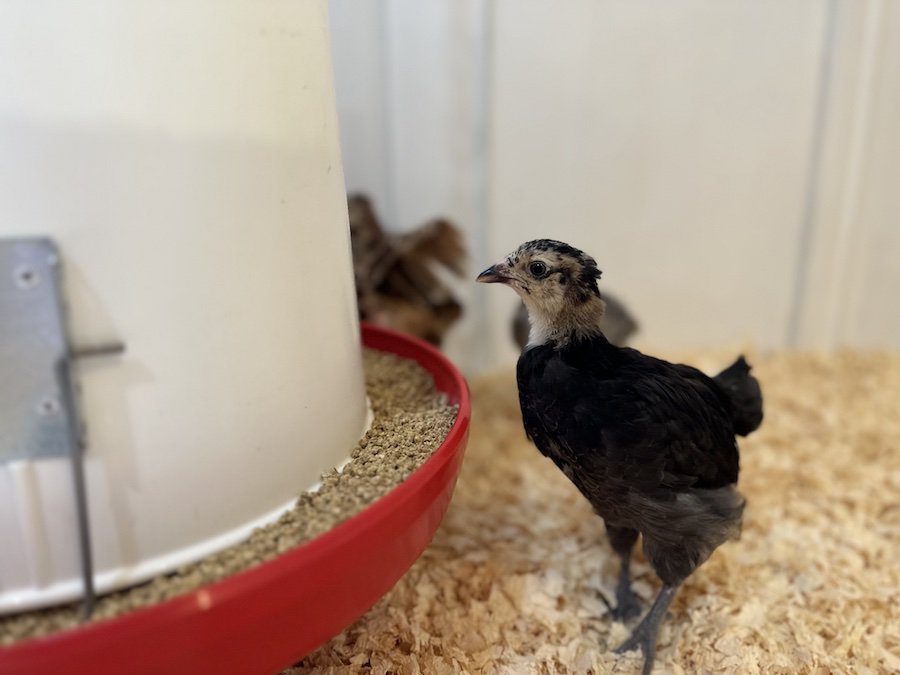
During the first 8 weeks of life, newly hatched chicks undergo rapid growth and development. To support their fragile bodies and promote healthy growth, it’s important to provide them with a specialized diet known as chick starter feed. This stage sets the foundation for the chickens’ overall health and productivity in adulthood.
Key Components of Chick Starter Feed
- High Protein Content – Newly hatched chicks have high protein requirements to support the development of muscles, feathers, and internal organs. Chick starter feed typically contains around 18-20% protein, ensuring that chicks receive the essential amino acids necessary for growth.
- Balanced Nutrition – In addition to protein, chick starter feed is formulated to provide a balanced mix of vitamins, minerals, and other nutrients essential for chick health. This includes vitamins such as vitamin A, vitamin D3, and vitamin E, as well as minerals like calcium, phosphorus, and magnesium.
- Medicated vs. Non-Medicated Options – Often chick starter feed comes in either medicated or non-medicated. Personally, we also start our chicks on medicated feed. This contains amprolium, which helps develop an immunity to coccidiosis by reducing the growth of coccidia oocysts. However, it can lead to thiamine deficiency as it’s a thiamine blocker. Be cautious and monitor for any symptoms of deficiency if using medicated feed.
- Fine Texture – Chick starter feed is typically ground into fine texture crumbs to make it easier for chicks to consume. The small particle size ensures that chicks can readily peck and digest the feed, reducing the risk of feed wastage and promoting efficient nutrient absorption.
- Palatable and Digestible Ingredients – Quality chick starter feed is made from highly palatable and digestible ingredients that encourage chicks to eat and support their delicate digestive systems. Common ingredients include grains like corn, wheat, and barley, as well as protein sources such as soybean meal or fish meal.
Feeding Recommendations
We are not medical professionals and can only give recommendations on feeding. Always review the instructions on your feed bags or consult with your veterinarian if you have any questions or concerns.
- Offer chick starter feed from day one, ensuring that fresh feed is always available in clean feeders.
- Chicks should have access to clean, fresh water at all times. Proper hydration is essential for chick health and digestion.
- Monitor chicks closely for signs of illness or nutritional deficiencies, such as lethargy, poor appetite, or abnormal droppings, and adjust feeding practices as needed.
- Always check the expiry date on your feed before using it.
- Gradually transition chicks to grower feed around 8 weeks of age as they begin to outgrow their high-protein requirements and prepare for the next stage of growth.
Grower Feed (8-18 weeks)
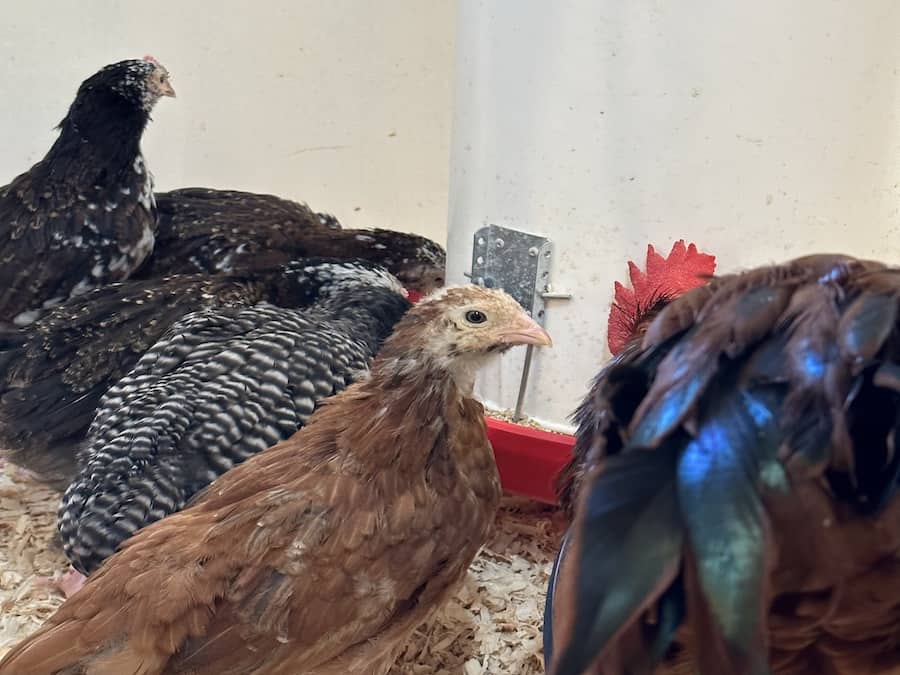
As chicks transition from the early stages of life into the pullet and cockerel stages, their dietary needs evolve to support continued growth and development. This is when you will gradually switch their feed to Grower feed. It provides the essential nutrients and energy needed for healthy muscle development, feather growth, and overall vitality.
Key Components of Grower Feed
- Moderate Protein Levels – Grower feed typically contains slightly lower protein levels than chick starter feed, with protein content ranging from 15-16%. While chicks still require protein for growth and tissue repair, their growth rate begins to slow down during this stage, necessitating a moderate reduction in protein intake.
- Balanced Nutrition – Similar to chick starter feed, grower feed is formulated to provide a balanced mix of vitamins, minerals, and other essential nutrients. This includes vitamins such as vitamin A, vitamin D3, vitamin E, and minerals like calcium, phosphorus, and magnesium, which are good for bone development and overall health.
- Reduced Calcium Levels – Unlike layer feed, which contains higher levels of calcium to support eggshell formation, grower feed typically contains lower levels of calcium. Excessive calcium intake during the grower stage can lead to kidney damage and other health issues.
- Energy-Dense Ingredients – To meet the increasing energy requirements of growing chickens, grower feed may contain energy-dense ingredients such as grains, fats, and oils. These ingredients provide the necessary calories to support physical activity, maintain body temperature, and fuel the metabolic processes associated with growth.
Feeding Recommendations
- Introduce grower feed gradually around 8 weeks of age, slowly replacing chick starter feed over the course of a few days to allow chicks to adjust to the new diet.
- Place grower feed in clean feeders, ensuring that fresh feed is always available.
- Provide access to clean, fresh water at all times.
- Avoid feeding additional calcium supplements or treats high in calcium during the grower stage.
- Grower feed will come in crumbs or pellet form. While the type you choose is your own preference, we will note that pellets tend to be less wasteful in our experience.
Layer Feed (18+ weeks)
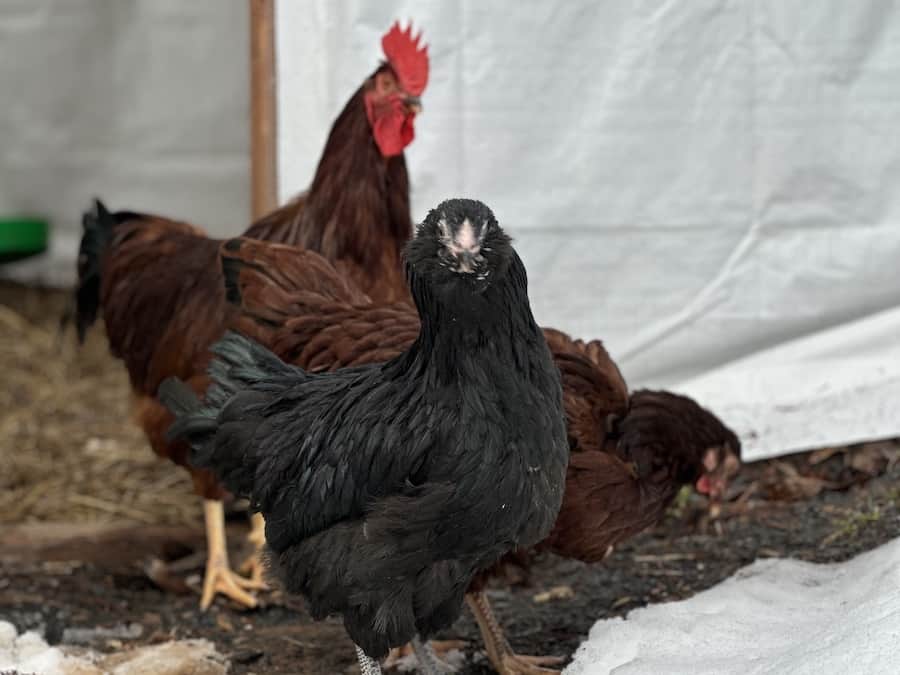
Once your chickens have reached their adult stage, typically around 18 weeks, their dietary requirements shift to support egg production, shell quality, and overall reproductive health. Layer feed is specifically formulated to meet these needs, providing the essential nutrients and minerals required for consistent egg production and strong eggshells.
Key Components of Layer Feed
- High Calcium Content – One of the defining features of layer feed is its high calcium content, typically ranging from 16-18%. Calcium is essential for eggshell formation, so providing adequate levels of this mineral will help maintain strong, healthy eggs. Layer feed often contains added calcium sources such as limestone or oyster shells to ensure hens receive sufficient amounts.
- Balanced Nutrition – In addition to calcium, layer feed is formulated to provide a balanced mix of vitamins, minerals, proteins, and fats necessary for overall health and egg production. This includes vitamins such as vitamin A, vitamin D3, vitamin E, and minerals like phosphorus, magnesium, and potassium.
- Omega-3 Fatty Acids – Some layer feeds may contain added omega-3 fatty acids, which can enhance the nutritional quality of eggs. Omega-3s are beneficial for heart health and may also improve egg yolk colour and flavour. Common sources of omega-3s in layer feed include flaxseed or fish oil.
- Controlled Protein Levels – While protein is still important for laying hens, layer feed typically contains slightly lower protein levels compared to chick starter or grower feed. Protein content in layer feed generally ranges from 15-18%, providing the amino acids necessary for egg production without excessive nitrogen excretion.
Feeding Recommendations
- Introduce layer feed gradually once hens reach laying age, typically around 18-20 weeks old. Transitioning slowly from grower feed to layer feed over the course of a week can help prevent digestive upset and ensure a smooth transition.
- Always provide access to clean, fresh water at all times.
- Monitor egg production, shell quality, and hen condition closely, adjusting feeding practices as needed to support consistent laying and maintain optimal body condition.
- Avoid feeding layer feed to non-laying birds or roosters, as the high calcium content can lead to health issues such as kidney damage. If you do have roosters and hens in the same coop – consider keeping them on grower feed and supplementing calcium into your hen’s diets using oyster shells or crushed egg shells.
- Just like grower feed, layer feed is available in crumbs or pellet form. While the type you choose is your own preference, in our experience, pellets tend to be less wasteful.
Safe Table Scraps For Chickens
Chickens are known for their omnivorous diet and can enjoy a wide variety of table scraps as treats. This is a great way to provide nutritious meals for your hens and to recycle your table scraps. However, not all leftovers are safe or beneficial for chickens. It’s important to offer only chicken-safe scraps and to avoid toxic or harmful food items.
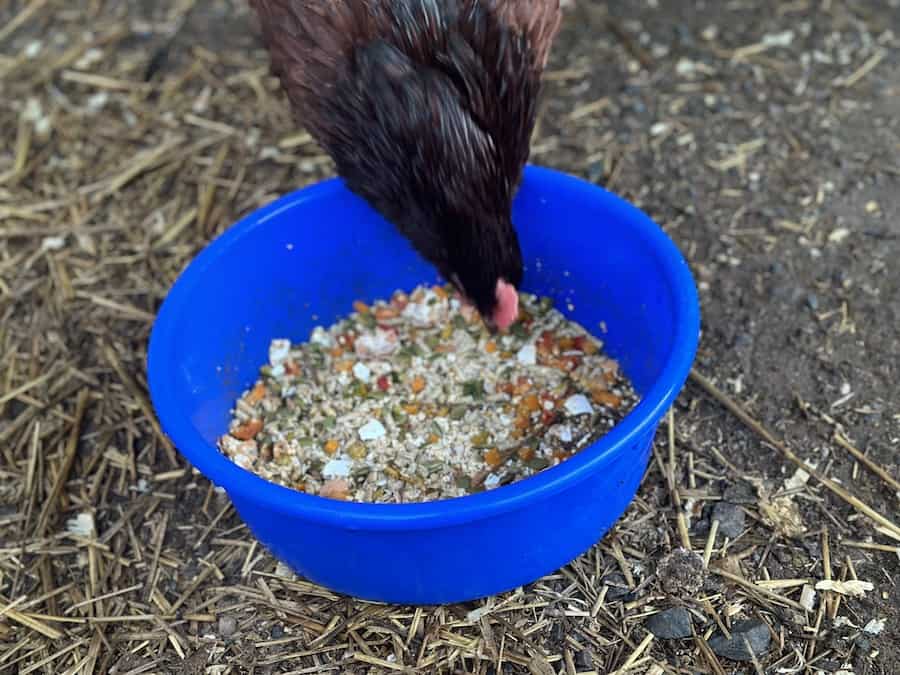
Here are some examples of safe table scraps that chickens can eat.
Vegetables
- Leafy greens such as lettuce, spinach, kale, and Swiss chard
- Carrots
- Broccoli
- Cucumber
- Squash
- Pumpkin
- Corn
- Peppers
- Garlic
Fruits
- Apples (with seeds and core removed)
- Berries such as blueberries, strawberries, raspberries, and blackberries
- Melons such as watermelon, cantaloupe, and honeydew (remove seeds and rind beforehand)
- Bananas
Grains and Carbohydrates
- Plain rice
- Rolled or cooked oats
- Quinoa
- Pasta
Proteins
- Cooked eggs
- Dried mealworms
Dairy (in moderation)
- Plain unsweetened yogurt
Supplements And Treats For Chickens
In addition to regular feed, chickens can benefit from a variety of supplements and treats. Added food can help provide additional nutrition, enrichment, health benefits and influence the taste of eggs. When giving supplements and treats to chickens, opt for high-quality options that complement their diet and support their overall well-being.
Here are a few ideas of supplements and treats that you can feed your chickens.
Grit
- Grit is small, insoluble particles such as sand, pebbles, or crushed granite that chickens consume to help grind and digest their food in the gizzard.
- Offer poultry grit in a separate feeder to ensure that chickens have access to it as needed. Chicks may require chick-sized grit, while adult chickens can consume larger-sized grit.
- Grit is especially for chickens that are free-range or have limited access to soil, as they may not be able to naturally find enough grit to meet their needs.
Calcium Supplements
- Calcium is important for laying hens to produce strong eggshells. While layer feed contains sufficient calcium for most hens, providing additional calcium supplements can be beneficial, especially for older or heavy-laying birds.
- Crushed Oyster Shells are a popular calcium supplement for laying hens. You can mix it directly into their feed or provide a separate container for it.
- Save and crush clean, dried eggshells from your own eggs and offer them back to your chickens as a calcium source. Wash and dry eggshells thoroughly before crushing.
Healthy Treats
- Dried mealworms are a protein-rich treat that chickens love. They’re available at most pet stores or can be raised at home using mealworm farms.
- Raw, unsalted sunflower seeds are a nutritious treat for chickens. They’re high in protein, healthy fats, and vitamin E.
- Offer dried fruits such as raisins, cranberries, or apricots as occasional treats. Chop larger fruits into small pieces for easy consumption.
- Herbs like parsley, basil, mint, and oregano are not only tasty but also provide health benefits for chickens. Offer fresh herbs as a treat or scatter them in the coop for chickens to forage.
- Warm oatmeal with spices such as cayenne, cinnamon or turmeric is a great treat for your chickens during the winter months.
Supplements
- Probiotic supplements can support digestive health and immune function in chickens. Look for poultry-specific probiotic products containing beneficial bacteria like Lactobacillus and Bifidobacterium.
- Poultry electrolytes can be life-saving during the warmer months or while a chicken is sick and has a reduced appetite. Electrolytes can be used in your flock’s water to help boost their energy and keep them hydrated.
- We like to keep additional supplements, such as vitamin B complex and apple cider vinegar on hand to support specific health needs or address deficiencies. As always, consult with a veterinarian for guidance on supplementing your flock’s diet.
Related Articles
• Why Chickens Eat Their Own Eggs & How To Stop It






